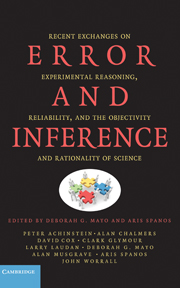 Error and Inference
Error and Inference Book contents
- Frontmatter
- Contents
- List of Contributors
- Preface
- Introduction and Background
- 1 Learning from Error, Severe Testing, and the Growth of Theoretical Knowledge
- 2 The Life of Theory in the New Experimentalism
- 3 Revisiting Critical Rationalism
- 4 Theory Confirmation and Novel Evidence
- 5 Induction and Severe Testing
- 6 Theory Testing in Economics and the Error-Statistical Perspective
- 7 New Perspectives on (Some Old) Problems of Frequentist Statistics
- 8 Causal Modeling, Explanation and Severe Testing
- 9 Error and Legal Epistemology
- Index
- References
7 - New Perspectives on (Some Old) Problems of Frequentist Statistics
Published online by Cambridge University Press: 29 January 2010
- Frontmatter
- Contents
- List of Contributors
- Preface
- Introduction and Background
- 1 Learning from Error, Severe Testing, and the Growth of Theoretical Knowledge
- 2 The Life of Theory in the New Experimentalism
- 3 Revisiting Critical Rationalism
- 4 Theory Confirmation and Novel Evidence
- 5 Induction and Severe Testing
- 6 Theory Testing in Economics and the Error-Statistical Perspective
- 7 New Perspectives on (Some Old) Problems of Frequentist Statistics
- 8 Causal Modeling, Explanation and Severe Testing
- 9 Error and Legal Epistemology
- Index
- References
Summary
Statistics and Inductive Philosophy
What Is the Philosophy of Statistics?
The philosophical foundations of statistics may be regarded as the study of the epistemological, conceptual, and logical problems revolving around the use and interpretation of statistical methods, broadly conceived. As with other domains of philosophy of science, work in statistical science progresses largely without worrying about “philosophical foundations.” Nevertheless, even in statistical practice, debates about the different approaches to statistical analysis may influence and be influenced by general issues of the nature of inductive-statistical inference, and thus are concerned with foundational or philosophical matters. Even those who are largely concerned with applications are often interested in identifying general principles that underlie and justify the procedures they have come to value on relatively pragmatic grounds. At one level of analysis at least, statisticians and philosophers of science ask many of the same questions.
What should be observed and what may justifiably be inferred from the resulting data?
How well do data confirm or fit a model?
What is a good test?
Does failure to reject a hypothesis H constitute evidence confirming H?
How can it be determined whether an apparent anomaly is genuine? How can blame for an anomaly be assigned correctly?
Is it relevant to the relation between data and a hypothesis if looking at the data influences the hypothesis to be examined?
How can spurious relationships be distinguished from genuine regularities?
How can a causal explanation and hypothesis be justified and tested?
[…]
- Type
- Chapter
- Information
- Error and InferenceRecent Exchanges on Experimental Reasoning, Reliability, and the Objectivity and Rationality of Science, pp. 247 - 330Publisher: Cambridge University PressPrint publication year: 2009
References
- 3
- Cited by


